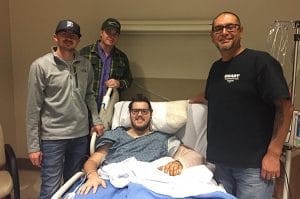The Republican tax bill would result in millions of dollars in cuts to the Railroad Unemployment Insurance Trust Fund and take funds away from out-of-work employees. Tell your senators and representatives to VOTE NO.
Next week, the House and Senate are expected to vote on a tax bill that is expected to add $1.5 trillion to $2 trillion to the federal deficit in the form of corporate and individual tax cuts. According to estimates, the Railroad Unemployment Insurance Trust Fund could lose as much as $9 million without any subsequent action by Congress under a 2010 budget process known as sequestration.
“Required spending reductions would significantly exceed the total resources available to be sequestered,” said Michele Neuendorf, a Railroad Retirement Board (RRB) labor member counsel, in an email. “This would have the practical result of a 100% sequestration of all non-exempt direct spending accounts including the funds from the Railroad Unemployment Insurance Trust Fund which is used to pay unemployment and sickness benefits.”
Under the federal “Pay-As-You-Go” (PAYGO) Act of 2010, federal spending is required to balance or offset any increases to the federal budget deficit (also known as sequestration). As a result, the tax bill would trigger automatic budget cuts across all federal programs including the RRB’s Railroad Unemployment Trust Fund, which is targeted for a 6.6 percent cut or approximately $9 million in the 2018 fiscal year by the administration.
“This tax proposal is Robin Hood caught in reverse,” said SMART Transportation Division National Legislative Director John Risch. “It would take from the poor and give to the rich. If the tax bill becomes law, the railroads will still be able to deduct money that they spend on union-busting lawyers while our members will no longer be able to deduct their union dues. The corporate tax rate for the big railroads will go from 35% to 21% while ours will stay the same with fewer deductions.”
It also means that $9 million intended for ailing and unemployed rail workers doesn’t go where it was supposed to. Instead it will go into the pockets of corporations and the well-to-do.
“Every person in America should be outraged that the Republican tax bill will borrow $1.5 trillion to $2.5 trillion to fund tax cuts for the wealthy while leaving no room for future federal investments toward infrastructure projects such as airports, transit systems, and passenger railroads,” Risch said. “I’ve been in the business of government policy since the 1980s and this is simply the worst tax proposal I have ever seen. Economists across the political spectrum are condemning this plan and the Republicans are so desperate for some sort of ‘win’ they are moving forward with little to no transparency or accountability to their constituents.”
Time is running out. A vote is planned for next week. Call your senators and representatives and urge them to vote against the tax bill.
Find out who your members of Congress are by accessing the SMART-TD Legislative Action Center or call the U.S. Capitol switchboard at (202) 224-3121.
Author: bnagy
A local treasurer workshop Feb. 21 to 23 will provide hands-on training on the responsibilities and duties pertaining to their office, including direct receipts, iLink and WinStabs. It will also focus on proper completion of monthly billings and member record maintenance.
This training will also be LIVESTREAMED for participants who are unable to attend in person at the SMART Transportation Division office — 24950 Country Club Blvd., North Olmsted, OH 44070.
Registration is required for both in-person and web-based attendance. Contact Alyssa Patchin at (216) 227-5281 or apatchin@smart-union.org to register and for discounted hotel rates if you are traveling to the workshop. Space is limited, and attendees will be accepted on a first-come basis.
The three-day session will include all training and materials at no cost to the local. However, the local is responsible for all other costs associated with the treasurer’s attendance at the workshop. Lost time or salary, travel, hotel and meal expenses connected with attendance may be reimbursed if pre-approved at the local meeting as an allowable expense of the local. Local treasurers are responsible for their own travel/lodging arrangements.
The standard basic daily and mileage rates of pay negotiated under the new National Rail Agreement are now available on the SMART TD website.
The rate tables pertain to employees in the crafts of conductor, yardman, yardmaster, brakeman and engineer who are covered by the national contract and are retroactive to July 1, 2016.
The ratified contract covers more than 35,000 SMART Transportation Division members employed by BNSF, CSX, Kansas City Southern, Norfolk Southern, Soo Line, Union Pacific and numerous smaller carriers – all represented in national handling by the rail industry’s National Carriers’ Conference Committee.
To view the rates, select “Documents” in the blue-line menu bar near the top of the SMART TD homepage, then select “Rates of Pay.” For a direct link to the rate tables, follow this link.
A special webpage has been created for members to read and download various documents related to the newly ratified National Rail Agreement that was approved by SMART TD members on Dec. 1, 2017.
Follow this link to view the signed agreements, questions and answers, a synopsis of the contract and other documents.
The page will be updated with additional information as available.
A ride on a UTV in September nearly turned fatal for Shane Leach when he severed an artery in his arm and nearly bled to death in the desert.
While out with a friend, Leach’s vehicle tipped on a turn. It rolled onto his arm, pinning it between the UTV and the ground.

“I was in surgery almost every other day just to work on my arm,” the 21-year-old from Las Vegas said.
And Leach, a new hire as a conductor in April for Union Pacific, said that he was about two weeks short of receiving full union benefits when the accident happened.
“It put me in a spot where I had to just figure things out,” he said.
But SMART Transportation Division Nevada State Legislative Director Jason Doering, Local 1117 President Wyatt Kelly, and Vince Ybarra, chairman of Local 1117, in Las Vegas, Nev., and others weren’t going to let Leach figure it out alone. They visited Shane in the hospital before his November discharge and helped to lift his spirits.
“They’ve called and checked in on him,” said Brenna Bristol Leach, Shane’s mother. “He really wants to go back to work, he really enjoyed the culture. The outreach from the guys has solidified that.”
Shane Leach said a recent drive past a local railyard reminded him how he can’t wait to get back aboard.
“I just thought – I loved my job when I got it,” he said. “It was really tough in the hospital to have that taken away. It just motivates me to do as much work as I can to get back.
“It really showed me how much I really enjoy being a railroader.”
Bristol Leach said the doctors who cared for Shane in the hospital have said that he’ll recover use of his arm, but a timeline has not been defined – there’s still physical therapy and orthopedic exams for Leach to power through, which means more time away from work and more stress on his depleted savings.
“It could be six months, it could be less, it could be more,” Bristol Leach said.
But the major surgeries and skin grafts have been successful for Shane, she said, and her son remains upbeat for an eventual return to the railroad alongside his future SMART TD brothers and sisters.
“It really makes me feel good that they haven’t given up on me, and it motivates me to get through the therapy and get back out on the rails,” Leach said.
A GoFundMe online fundraiser has been set up at https://www.gofundme.com/shanes-medical-fund-recovery as Shane continues to recover. Any help would be appreciated.

At the end of 2001, Labor and Management had agreed on various procedures to administer the annual changes in the amount of the lifetime maximum benefit under the ERMA Plan.
In conjunction with the formula established in 2001, a new lifetime maximum was calculated by utilizing the October 2017 consumer price index (CPI) data for Hospital and Related Services and Physician Services. The result is a lifetime maximum for 2018 of $162,500.
For individuals who have reached the lifetime maximum, the incremental maximum available is applied to eligible expenses submitted for dates of service on or after the effective date of the new maximum. For 2018, this amount will be $4,700.
This change will apply to all railroads and crafts participating in ERMA.

